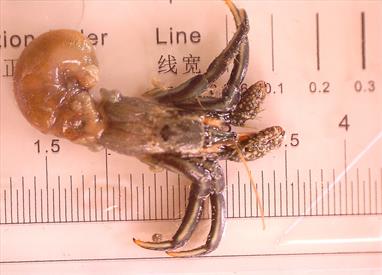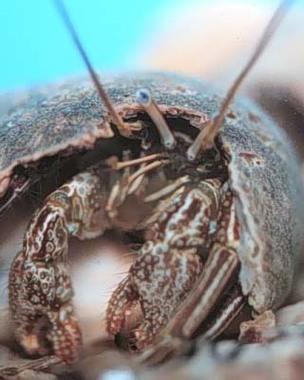



Clibanarius vittatus
Size
To 5cm.
Description:
The body and legs are dark green or brown; the body is faintly streaked with white and the legs have distinct white or grey stripes. Claws similarly sized.
Ecology
C. vittatus is a scavenger and mostly feeds on detritus that it finds on the seabed. It is more resistant to desiccation than many hermit crabs and is found in the intertidal zone as well as at depths down to about 20 metres (70 ft). It can be found on sand or mud, in seagrass meadows, on rock jetties, in oyster beds and in other inshore habitats. C. vittatus inhabits a variety of gastropod shells, commonly from whelk and conch species. Can be found with a sea aenenome on the shell in a mutualistic symbiosis.
Life Cycle
Reproduction in Clibanarius vittatus is initiated by the passing of spermatophores from a male crab to a female. The egg mass of several thousand eggs is brooded by the female on her abdomen. After a few weeks the eggs hatch and the larvae are released into the water column and become planktonic. They pass through four or five zoeal stages and one post-larval, glaucothoe stage before sinking to the bottom and metamorphosing into juveniles.[ The free-living glaucothoe larvae sometimes find a suitable sized shell before metamorphosis, otherwise the juveniles need to find suitable new homes before they are consumed by predators. An adult female has several broods each year and may produce 180,000 eggs during the reproductive season
To 5cm.
Description:
The body and legs are dark green or brown; the body is faintly streaked with white and the legs have distinct white or grey stripes. Claws similarly sized.
Ecology
C. vittatus is a scavenger and mostly feeds on detritus that it finds on the seabed. It is more resistant to desiccation than many hermit crabs and is found in the intertidal zone as well as at depths down to about 20 metres (70 ft). It can be found on sand or mud, in seagrass meadows, on rock jetties, in oyster beds and in other inshore habitats. C. vittatus inhabits a variety of gastropod shells, commonly from whelk and conch species. Can be found with a sea aenenome on the shell in a mutualistic symbiosis.
Life Cycle
Reproduction in Clibanarius vittatus is initiated by the passing of spermatophores from a male crab to a female. The egg mass of several thousand eggs is brooded by the female on her abdomen. After a few weeks the eggs hatch and the larvae are released into the water column and become planktonic. They pass through four or five zoeal stages and one post-larval, glaucothoe stage before sinking to the bottom and metamorphosing into juveniles.[ The free-living glaucothoe larvae sometimes find a suitable sized shell before metamorphosis, otherwise the juveniles need to find suitable new homes before they are consumed by predators. An adult female has several broods each year and may produce 180,000 eggs during the reproductive season

| Ecological Descriptors | ||||
| Habitat | Size (cm) | Diet | Behaviour | Sex |
| R, Co | 5 | Sca, Det | Sh | F |
Greenstriped Hermit Crab
SYNONYMS
Thinlined Hermit Crab
Thinlined Hermit Crab




248


